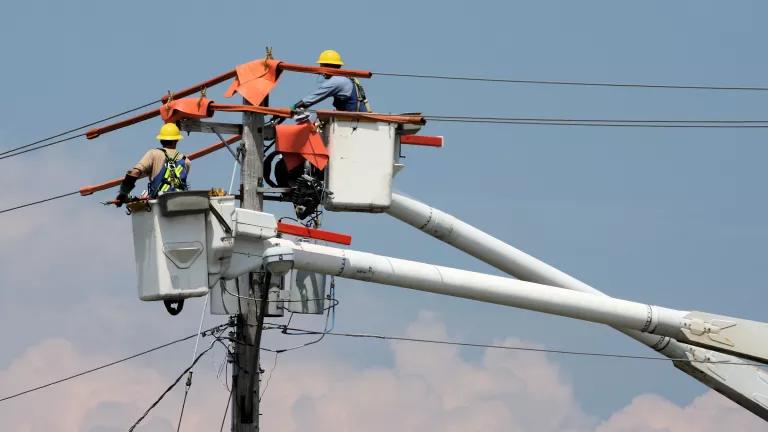The question on people’s minds as we dig into the carbon pollution reduction standards proposed by the U.S. Environmental Protection Agency is – what does it mean for Ohio?
Two weeks ago, EPA issued a long-awaited standard – called EPA’s “Clean Power Plan” – for carbon pollution from our nation’s existing power plants. The announcement was greeted by numerous positive statements from lawmakers, utilities, businesses, environmental and consumer groups, and constituents across the country and even some constructive statements from quarters expected to be critical.
But how will these standards be implemented cost-effectively in Ohio, a carbon-intensive state that just passed a law to freeze its efficiency and renewables mandates for the next two years? The good news is that Ohio is already paving the way to meeting these standards, by using what is already working – clean energy.
Here are some fundamentals to keep in mind while analyzing what the carbon pollution standards will mean for Ohioans:
- The state has already made significant progress in cutting carbon pollution over the last few years and has the potential to slash it even further in a cost-effective manner.
- Energy efficiency and renewables are vital tools in Ohio’s compliance toolbox, making the state’s clean energy policy an essential part of the path forward.
- Done right, Ohio stands to expand its clean energy economy while striving to cut pollution in ways that will improve health and the environment – and keep consumers’ energy bills low.
How Ohio’s carbon reduction target was set
As the Clean Power Plan was being released, EPA Administrator Gina McCarthy quipped, “We are not doing cutting edge work here folks.” She was referring to the fact that EPA based the carbon reduction targets on a conservative assessment of steps states are already successfully taking to curb emissions.
EPA conducted an exhaustive review of the potential reductions, taking into account each state’s unique starting point, energy mix and resource opportunities. As NRDC notes, EPA established state pollution reduction targets by looking at four “building blocks:”
- Making coal plants more efficient.
- Using existing natural gas plants more effectively.
- Ramping up energy efficiency savings from utility-run programs for things like weatherization and upgraded appliance rebates.
- Growing utility investment in renewable energy and averaging in 6% of a state’s existing nuclear generation in the emissions target.
EPA then applied these building blocks uniformly to each state’s energy mix and developed a carbon intensity target for the state (carbon intensity measures the amount of carbon produced for each unit of power generated). Each state is given an interim target for 2020 and a final goal for 2030.
Based on this formula, Ohio has a carbon intensity reduction target of 22 percent by 2020, and 28 percent by 2030. Expressed as lbs/MWh, Ohio’s starting point is 1,850, which is reduced to 1,452 by 2020, and 1,338 by 2030.
Another key feature of the standard is that EPA has listened to requests for flexibility and placed each state – including Ohio – in the driver’s seat to chase down their target as they see fit. Putting states in charge of implementation is an approach that has been used repeatedly and successfully to achieve goals under the Clean Air Act.
What this means for Ohio
Ohio’s reduction target may sound daunting for a state that relies on coal for nearly 70 percent of its power. Not so. Ohio is on track to achieving these emissions reductions.
Following the release of the EPA proposal, the state’s investor-owned utilities confirmed that significant reductions have already occurred – and more are being planned – at their coal-fired power plants. Duke Energy reported that it has made changes that could be a step toward compliance, having already cut carbon emissions across its nationwide fleet by nearly 20 percent from their 2005 levels. AEP, one of the nation’s largest carbon dioxide emitters, said it’s producing 21 percent less carbon than it did in 2005 and that it plans to retire another 6,600 megawatts of coal plants by late 2015 – which will bring it to 25 percent below 2005. Even First Energy – the largest power provider in Ohio and a utility that has very publicly led the charge against a clean energy future in the state – said it “believes it is in a strong position to meet the requirements in the proposed rule."
These are encouraging statements, especially considering the patently inaccurate and alarmist claims in the days leading up to the release of the power plant standards. It’s notable that the reaction to the proposal from the utilities that will actually be tasked with reducing emissions is far more measured.
Another key factor that has put Ohio ahead of the game is that it’s home to some of the nation’s most robust clean energy standards – and EPA has empowered the state to take full advantage of them. These standards – which have spelled billions of dollars in energy bill savings for Ohioans and supported a fast-growing economy - will be an important part of the calculus as the power sector devises a compliance strategy.
The EPA proposal assumes states will be able to reduce energy use by 1.5 percent annually through energy efficiency. Ohio is en route to achieving this now, with a standard that will soon (assuming the clean energy freeze ends as promised in 2017) ramp up to 1 percent per year, and ultimately to 2 percent – exceeding EPA’s assumptions. These investments in energy efficiency will reduce carbon emissions by 32 million tons annually – roughly the amount that would be emitted by 6.7 million cars.
And Ohio gets even more bang for its energy efficiency buck than carbon emissions: a fortified clean energy economy that means more jobs for Ohioans. A recent NRDC analysis demonstrates that doubling down on energy efficiency as part of the state’s implementation plan can put 8,600 Ohioans to work in the energy efficiency economy, and reduce the state’s total electric bill by about $399 million per year (or $6.80 per month for every household). If Ohio capitalizes further on this potential, these gains will be even larger.
EPA’s renewable assessment for the standards was set conservatively by looking at what states in each region are already doing or planning to do. Ohio was grouped with states in the “East Central” region (along with Pennsylvania, New Jersey, Virginia and others), in which EPA assumed a 16 percent renewables growth potential by 2030.
Ohio currently requires that 12.5 percent of the electricity sold be generated from renewable energy sources by 2025. To date, the state’s utilities have achieved a cumulative 2.5 percent toward that eventual target. Assuming they continue on this trajectory, and add additional renewable energy to the mix between 2025 and 2030, Ohio could meet and exceed the EPA goal.
As noted above, it’s up to Ohio to decide exactly what role renewables and efficiency will play in meeting its target. But these clean energy policies are a win-win way for the state to get there.
The fly in the ointment: SB 310
EPA’s proposal represents a tremendous opportunity for Ohio to use what’s already working for the state to cut carbon emissions. And that’s energy efficiency and renewable energy.
But the proposal also underscores what was already clear – that the decision to freeze these clean energy standards just when Ohio needs them the most is woefully shortsighted.
With the Governor’s signing of the two-year freeze last week, Ohio could forgo, for now, significant clean energy investments, along with the jobs and health benefits that come with them. This ill-advised decision will put the state at a disadvantage in complying with the Clean Power Plan.
But now that EPA’s proposal has been released and clean energy has emerged as the “jewel in the crown,” policy-makers in Ohio should revisit their decision – the sooner the better. As one of the nation’s most carbon-intensive states, Ohio is positioned to be a leader in constructively and cost-effectively crafting a smart compliance plan – fostering a thriving clean energy economy in the process.
Now is the time to roll up our sleeves and get to work. Ohio is up to the task.



